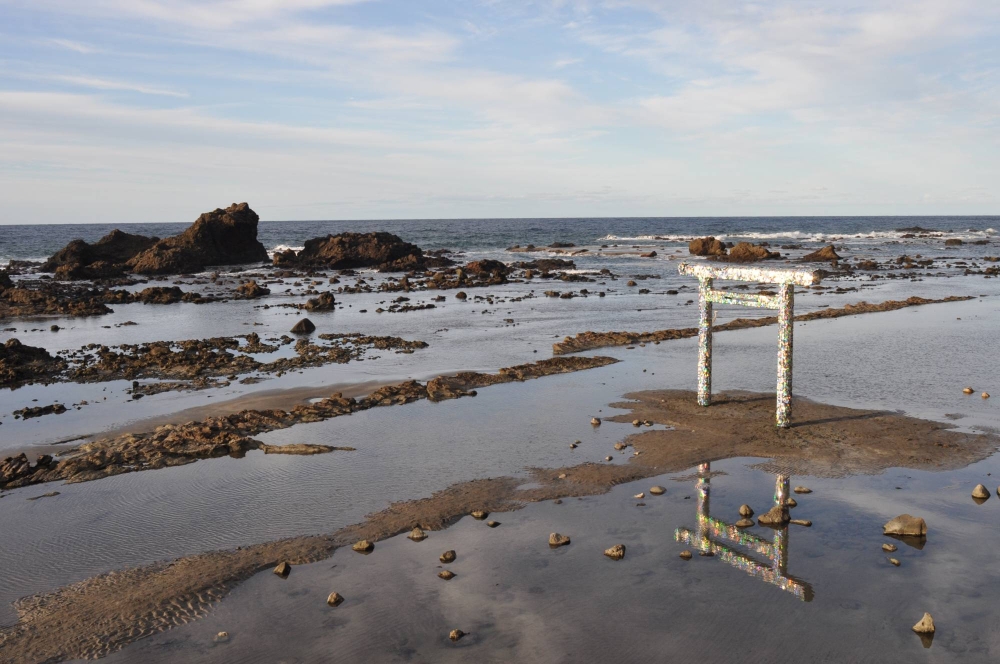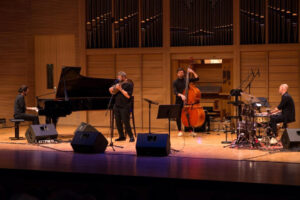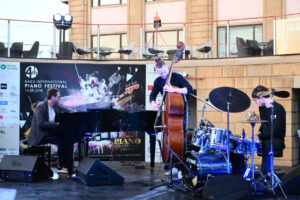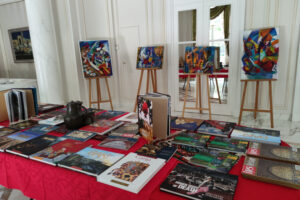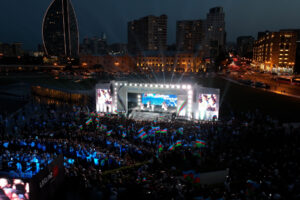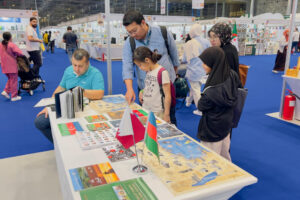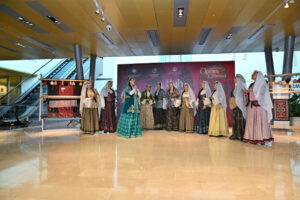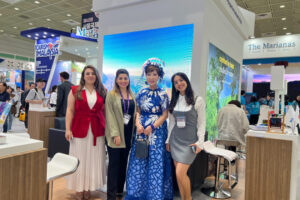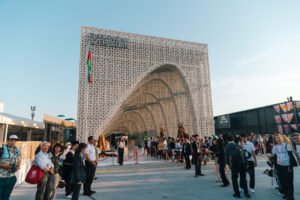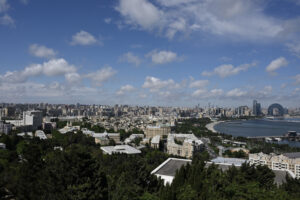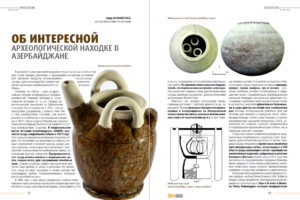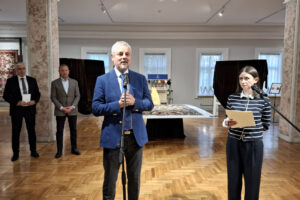Tokyo, 06 October, /AJMEDIA/
SUZU, ISHIKAWA PREF. – Where is it? I scan the road to the left, sweep across to the right, travel its length a second time, squint a bit. The brakes on this bike are rusty, so I’m pedaling molasses-slow as I search the vintage storefronts on this deserted road, cautious not to break the silence with a screech. But why am I worried about noise? There’s no one here.
Then, a sign of life: People below the age of 60, sporting backpacks and sun hats. Tourists! Their phones are held up in ready position, the postures of people in search of directions or an angle for photos. I must be close. Then I spot the gently waving flags in the distance, clean white and bright cyan standing out against the faded shop doors and signage. Bingo. I cycle forward.
Suzu in Ishikawa Prefecture sits at the tip of a peninsula that juts out of the curve of Japan’s back. Since 2017, the city of 12,668 people has hosted the Oku-Noto Triennale, a contemporary art event that bills itself as “saihate no geijutsusai” (“the art festival at the farthest reaches”). The third edition, after being postponed following a 6.5 earthquake in May, opened on Sept. 23 with 34 new works by artists from Japan and abroad.
The festival is helmed by art director Fram Kitagawa and is designed as a government revitalization project, much like its older sister events, the Setouchi and Echigo-Tsumari Art triennales. As is true of cities all across Japan, Suzu’s population is steadily declining, down from 16,279 just a decade prior. It’s a remote place: From Tokyo, the shinkansen takes you as far as Kanazawa, Ishikawa Prefecture, and then it’s another three-hour bus that only runs a few times a day — or you can take one of only two flights that land on the peninsula daily, both from Haneda Airport. The festival aims to breathe new life into the region by instilling pride in the local population for their home city, and by bringing in tourists and their wallets.
In lieu of any curatorial theme, the works take shape around the site itself: Artists use local materials and center their ideas around local issues, and local residents pitch in for installation and volunteer to help run the festival. If there were any unifying vision, it would surely be, “Suzu is great” — international art biennale as local hype man.
A handful of the works repurpose abandoned schools, drawing outlines of children who are no longer there, the stickered name tags of former students still clinging to their cubbies. Maria Fernanda Cardoso is from Colombia and Australia, and one of the scant female artists showing at the festival. She collected 36,000 seedpods from the area, among them the strange, bat-shaped seeds of the caltrop plant from nearby beaches, and transformed a former nursery school into a recognizable white-walled gallery space. Volunteers cleaned the school, planted new growth outside and helped gather the seedpods. As Cardoso says, the enthusiastic helping hands got the job done in a fraction of the time she expected.
A piece from the triennale’s last edition, a collaboration between installation artist Yoshitaka Nanjo and musician Umitaro Abe at the Suzu Theater Museum, repurposed another former school’s gymnasium. The space displays tools and objects found lying in nearby homes and uses soil excavated from the ancient strata of Suzu to create an exhibit that is part natural history exhibit, part ramshackle seaside scene. An installation projects ocean waves onto the space, creating an exceptional piece that blends together the artifacts, earth, imagined water and sound.
On opening weekend, the beach-evoking backdrop was the stage for avant-garde and experimental dancer Min Tanaka, who performed his improvised “Locus Focus” pieces. There were a few moments of exuberance, and it was thrilling to see the 78-year-old exert such incredible control over his lean body. There were also times the structureless freefall felt a bit like waiting for Godot.
To bring more buzz and fanfare to this very remote place, Pritzker Prize-winning architect Shigeru Ban opened a new restaurant for the triennale beside the Suzu Theater Museum using Japanese cypress instead of his usual paper, creating a transparent glass box that seems to float above the sea.
A few of the newly commissioned works have been built to withstand the elements, which is no casual feat in Suzu. The area’s climate of constantly variable rain and wind means that even in May, its driest month, it gets an average of 98 millimeters of rain, almost double that of Tokyo. For this triennale, English sculptor Richard Deacon installed three works from his “Infinity” series, which he started in 2001. The interlocking stainless steel pieces crowd together like the curious faces of forest spirits, and the three mirrored surfaces are arranged to reflect back the sun, the sea and the local community, respectively.
Faig Ahmed of Azerbaijan has erected “Door to Yourself” directly on the beach near Godzilla Rock, a local landmark so named for its resemblance to the fictional monster that rose out of the ocean. From the road, a torii gate constructed by Ahmed is flat and stands out in relief against the rocks and sea, as if lit by brightly blinking lights. It seems obvious, inevitable: A foreign artist comes to Japan and makes a pop-y twist on one of its iconic traditional symbols. But at low tide, visitors can walk directly to the work and stand under it, which gives the piece much greater dimension. It’s not electricity making the work sparkle but rows of sequins affixed to the gate. Above the din of the whipping gale are some alien sounds that turn out to be wind moving through an aeolian harp. It skillfully manages to be both disco and experimental ambient concert, inviting and playful from far away but screechy and howling up close. The dramatic and rapidly shifting environs make the work dynamic from moment to moment — and just happens to make for very good social media posts. “Door to Yourself” is sure to join Chiharu Shiota’s 2017 installation, “The Boat which Carries Time,” a room dense with the artist’s knotted red strings, as one of the festival’s widely recognizable images.
The site-specific placement doesn’t work well everywhere: “Movement Field” by Shanghai’s Xu Zhen is a walking path of white cobblestones “based on the routes of real protests across time around the world.” But the message of “protest,” already vague and nebulous, is subsumed by the neat and photogenic work, which is inspired by Japanese garden design, a tradition that emphasizes harmony and a staid, contained peacefulness. Moreover, the installation is placed against the backdrop of the popular tourist attraction of Mitsuke Island, a great rock jutting out of the sea with sharply edged sides and a tree covering that resembles a mop of floppy hair. The quaint scene of the clean geometric lines of white stone and freshly mowed grass against the rock and sea makes any meaningful statement on political unrest seem empty and shallow.
This is an earnest festival bringing life to a truly remote part of Japan, so it’s hard to be too cynical. Still, there’s something missing in the overall program presented at Oku-Noto Triennale, and that’s any feeling whatsoever of discomfort. Neat and defanged, the art is safe, family-friendly and ready for the ’gram. Art, especially the kind that art people like, seeks to push boundaries and interrogate both form and content; while often individually strong, the works as a whole here offer a gentle, pretty program that steers deftly clear of any whiff of controversy.
Kitagawa’s impressive roster of artists and his curatorial ambitions brush up against this wholesomeness in an unscripted moment at the former Suzu train station: Artist Yu Sato, dressed in a train conductor outfit, illustrates a story written collectively by the audience in a glorified children’s classroom storytelling activity that would have elicited an eye roll from any “serious” art world person. In the parking lot, I watch as Tanaka, whose ghostly movements had me gripped with an unfamiliar anticipation the day before, get in his car and stare coolly out from below the brim of his cap, before driving away.

